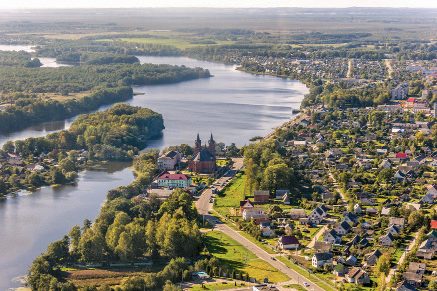By Dmitry Ampilov
Translated from Finno-Ugric as ‘lake in a low place’, the Miory District is a place of wetland marshes. Despite its past of creating environmental difficulties for local inhabitants, its natural beauty is also its treasure and, now, a source of income, thanks to tourism. We visited this untouched landscape in the northwest of Belarus to see with our own eyes.

500th anniversary of Miory combines with Cranes and Cranberries festival
On the day of our arrival, Miory was celebrating its 500th anniversary. Originally thought to have been established just over 350 years ago, ethnographer Vitold Yermolenok’s archive discovery of a document relating to the estate of Merey, in the Braslav District, in the Grand Duchy of Lithuania, dates Miory to 1514. Of course, it’s fashionable to enjoy eco-tourism these days, and the city’s Cranes and Cranberries festival was the perfect venue to promote the Yelnya marshes, being rich in the succulent berry.
The Chairman of Miory District Executive Committee, Igor Kuznetsov, tells us, “Unfortunately, this May, frosts affected the cranberry crop, so you need to go further to find berries. Yelnya may one day reap good dividends but we currently only add the smallest value to our harvests, selling our cranberries frozen to the European Union. This is the second year that we’re considering how best to organise berry processing: to make jams and other products. We’ve drafted business plans, and have found an investor, but face technical difficulties — in particular relating to the sanitary code.”
Yelnya’s berry revenue is worth $1.5-2m and the season is in full swing. It’s a profitable business, allowing the average family to earn $30-40 daily, gathering cranberries. The best collectors can gather up to 800kg of berries.

Miory is the district centre of the Vitebsk Region, with a population of 8,000, located 190km west of Vitebsk
Victor Derevyanchik, the Chairman of the Perebrodie Rural Executive Committee, emphasises, “Nobody will give you exact sums, as it’s a commercial secret, but many people in the district take holiday time to gather berries. They put on their boots and go out. Only locals venture onto the Boloto-Mokh hydrological reserve, but the Yelnya wetlands attract people from far and wide, since the money they can earn from harvesting cranberries is enough to support them comfortably over winter. Of course, it is hard work.”
Miory residents know that walking barefoot is good for your health, as visitors to the festival may be able to vouch for. Meanwhile, cranberries are rich in antioxidants and nutrients, and are perfect for use not just in juices and jams but in pies, cakes, sauces for savoury dishes, salads and, even, liqueurs.

People and birds of the marshes
Miory’s coat of arms bears a swan, as the bird commonly nests around the lake. Cranes are also used in association with the region, being regular visitors to the marshes. Children make paper cranes during the festival, and visitors flock to see the birds in their natural habitat, explains Anastasia Kuzmenkova, of the APB BirdLife Belarus organisation. So many festival visitors wished to see the cranes that buses were organised. She notes, “Cranes are the largest birds found in Belarus, at 120cm in length. In a single cornfield, you may see 300 or more. Once, about 7,000 were counted. Why do they choose Yelnya? It is one of the largest, high bogs in Europe, attracting birds from Scandinavia as they migrate to warmer climes. They stay until the end of October. The crane is included in the Red Book in fact.”

People and birds of the marshes
Yelnya marshes are home to 15 varieties of Red Book plant life, and 22 species of rare birds — among them several pairs of black-throated divers. This summer, an eco-route stretching 1.5km opened to tourists, to allow greater access to the wonderful landscape.
Interesting facts
 Miory is the regional centre of the Vitebsk district, with a population of 8,000, located 190km west of Vitebsk (where a number of food and wood processing industries operate, alongside other light-industries). It became a city in 1972 and is known for its Neo-Gothic Assumption Catholic Church: constructed in the early-20th century. The city’s local history museum displays items collected from across the region, including artefacts from ancient settlements and barrows, recovered under the direction of archaeologist Vadim Shadyro. Miory Lake now has a 500m quayside, which attracts many visitors. Famous people born here include: choral conductor Gennady Tsitovich — a People’s Artiste of the USSR; Soviet military leader and USSR Hero Vice-Admiral Yegor Tomko — who commanded the 11th Division of Nuclear Submarines of Krasnoznamensk Northern Fleet; and Belarusian neuropathologist Professor Iosif Sosnovik — a Doctor of Medical Sciences.
Miory is the regional centre of the Vitebsk district, with a population of 8,000, located 190km west of Vitebsk (where a number of food and wood processing industries operate, alongside other light-industries). It became a city in 1972 and is known for its Neo-Gothic Assumption Catholic Church: constructed in the early-20th century. The city’s local history museum displays items collected from across the region, including artefacts from ancient settlements and barrows, recovered under the direction of archaeologist Vadim Shadyro. Miory Lake now has a 500m quayside, which attracts many visitors. Famous people born here include: choral conductor Gennady Tsitovich — a People’s Artiste of the USSR; Soviet military leader and USSR Hero Vice-Admiral Yegor Tomko — who commanded the 11th Division of Nuclear Submarines of Krasnoznamensk Northern Fleet; and Belarusian neuropathologist Professor Iosif Sosnovik — a Doctor of Medical Sciences.DIRECT SPEECH
Igor Kuznetsov, the Chairman of the Miory District Executive Committee:
With our festival, we want to promote eco-awareness as widely as possible. Our interest lies not least in the fact that we have some peat sites which were developed in Soviet times but which now lie idle. If we can earn money from selling peat, we’ll be able to invest in maintaining our environment. The ‘Cranes and Cranberries’ festival has been a platform for education, encouraging people to be more aware of nature, rather than just making money from berry gathering. We’ve seen some success, and are now developing an investment project to construct a metal works. We’ve passed all the necessary ecological examinations in Canada and the USA. If I thought for even one moment that our district or city would suffer from the construction I would never have supported the idea but today’s metallurgical industry has no need for the blast furnaces used in the last century.











